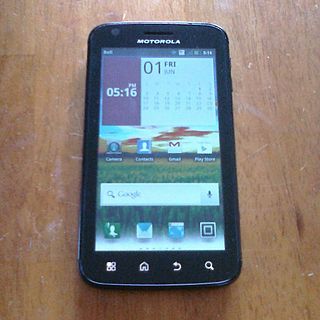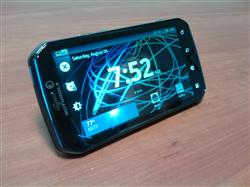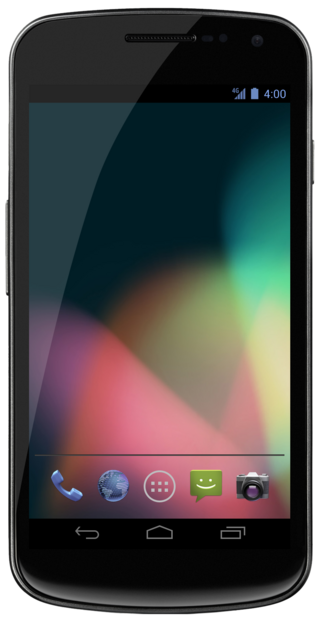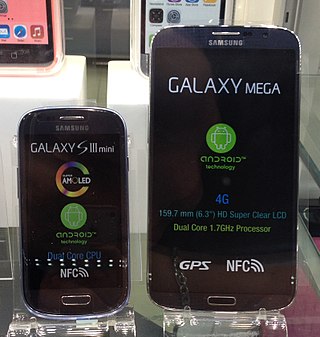Motorola Mobility LLC, marketed as Motorola, is an American consumer electronics manufacturer primarily producing smartphones and other mobile devices running Android. It is a subsidiary of the Chinese multinational technology company Lenovo.
A mobile operating system is an operating system for mobile phones, tablets, smartwatches, smartglasses, or other non-laptop personal mobile computing devices. While computers such as typical laptops are "mobile", the operating systems used on them are generally not considered mobile ones, as they were originally designed for desktop computers that historically did not have or need specific mobile features. This line distinguishing mobile and other forms has become blurred in recent years, due to the fact that newer devices have become smaller and more mobile unlike hardware of the past. Key notabilities blurring this line are the introduction of tablet computers and light-weight laptops and the hybridization of the two in 2-in-1 PCs.
Google Nexus is a discontinued line of consumer electronic devices that run the Android operating system. Google managed the design, development, marketing, and support of these devices, but some development and all manufacturing were carried out by partnering with original equipment manufacturers (OEMs). Alongside the main smartphone products, the line also included tablet computers and streaming media players; the Nexus started out in January 2010 and reached its end in October 2016, replaced by Google Pixel.

The Motorola Atrix 4G is an Android-based smartphone by Motorola, introduced in CES 2011 on January 5, 2011. It was made available in the first quarter of 2011. It was introduced along with three other products, Motorola Xoom, Motorola Droid Bionic, and Motorola Cliq 2. It uses an NVIDIA Tegra 2 dual core processor. It is the first phone to use a quarter-HD PenTile display with 24-bit graphics. The Motorola Atrix 4G is carried by the following wireless providers: AT&T Wireless US, Orange UK, Bell Canada CAN, Telstra AU. AT&T released Atrix on March 6.

The Motorola Droid Bionic is an Android-based, 4G LTE-capable smartphone designed by Motorola. It was originally scheduled for release in Q2 2011 but was delayed, eventually being released on 8 September 2011.

The Samsung Infuse 4G it was an Android smartphone that was released by Samsung in May 2011. It has a 1.2 GHz Hummingbird processor with 8–16 GB internal Flash memory, a 4.5 inch 480×800 pixel Super AMOLED Plus capacitive touchscreen display, an 8-megapixel camera and a 1.3-megapixel front-facing camera.

The Motorola Photon 4G was a high end Android-based mobile smartphone that was distributed exclusively by Sprint. A very similar model was available as the Motorola Electrify from U.S. Cellular.

The Galaxy Nexus (GT-I9250) is a touchscreen Android smartphone co-developed by Google and Samsung Electronics. It is the third smartphone in the Google Nexus series, a family of Android consumer devices built by an original equipment manufacturer partner. The phone is the successor to Google's previous flagship phones, the Nexus One and Nexus S.

The Verizon Droid Razr is an Android-based, 4G LTE-capable smartphone designed by Motorola that launched on Verizon Wireless on November 11, 2011. It was announced on October 18, 2011 in New York City.

Lenovo smartphones are marketed as the "LePhone" in Mainland China and the "IdeaPhone" overseas. Motorola Mobility, ZUK Mobile and Medion, divisions of Lenovo, sell smartphones under their own brands. As of September 2015, Lenovo is in the process of rebranding most of its phones using the Motorola brand name.

The Motorola Droid 4 (XT894) is a smartphone made by Motorola Mobility. It was released with Android 2.3 and can be upgraded to Android 4.1. It was released on Verizon Wireless's network on February 10, 2012. It is the successor to Motorola's Droid 3, and is one of the first smartphones to support GLONASS in addition to GPS.
The Motorola Photon Q 4G LTE (XT897) is a smartphone manufactured by Motorola which runs on Sprint's 4G LTE network. The "Photon Q" has a 4.3-inch touchscreen and a 1.5 GHz dual-core processor. It runs the Android operating system and includes a built-in, sliding keyboard similar to the one on the Motorola Droid 4.

The Droid Razr HD and Droid Razr Maxx HD are Android-based, 4G LTE-capable smartphones designed by Motorola as the successor to the Droid Razr series released nearly a year prior. Notable changes from their predecessors include 720p resolution displays and increased display size while maintaining similar overall dimensions. Additionally, the battery capacity on the standard Razr HD is 42% larger than its predecessor. Both go by the model number XT926. These phones were released on October 18, 2012 exclusively on Verizon Wireless in the United States. The Motorola Razr HD were available as international or global phones in Europe, Latin America, Australia and Canada as early as October 2, 2012. In the summer of 2013, storyboards surfaced of television commercials that have not yet aired. These commercials will feature the Droid Maxx and Droid Ultra, the apparent successors to the Droid Razr Maxx HD and Droid Razr HD, respectively.

The Samsung Galaxy Mega is an Android-based phablet that was manufactured and released by Samsung. It was announced on April 11, 2013. The original model featured a 6.3 in (160 mm) screen, though a revised version was released with a 5.8 in (150 mm) screen. It has a 1,280×720 screen, a dual-core 1.7 GHz processor and an 8-megapixel camera. The phone runs Android 4.2.2 "Jelly Bean" software, and internal storage is 8 or 16 GB.

Moto X is an Android smartphone developed and manufactured by Motorola Mobility, and released in August 2013.

The second generation Moto X, marketed as moto X and referred to in the media as Moto X (2014), is an Android smartphone developed by Motorola Mobility. Released on September 5, 2014, it is the successor to the original Moto X released in 2013. It was succeeded by the third generation Moto X Style and Play family, announced on July 29, 2015.

The Meizu MX4 is a smartphone designed and produced by the Chinese manufacturer Meizu, which runs on Flyme OS, Meizu's modified Android operating system. It is a previous phablet model of the MX series, succeeding the Meizu MX3 and preceding the Meizu MX5. It was unveiled on September 2, 2014 in Beijing.

The second generation Moto E is an Android smartphone developed by Motorola Mobility. Released on February 25, 2015, it is a successor to the Moto E released in 2014. The New Moto E is a low-end device for first-time smartphone owners or budget-minded consumers, and is available in 40 countries worldwide.

The Moto X Style is the flagship third-generation of Moto X Android smartphone developed and manufactured by Motorola that was released on September 2, 2015.

Samsung DeX is a feature included on some high-end Samsung handheld devices that enables users to extend their device into a desktop-like experience by connecting a keyboard, mouse, and monitor. The name "DeX" is a contraction of "Desktop eXperience".

















